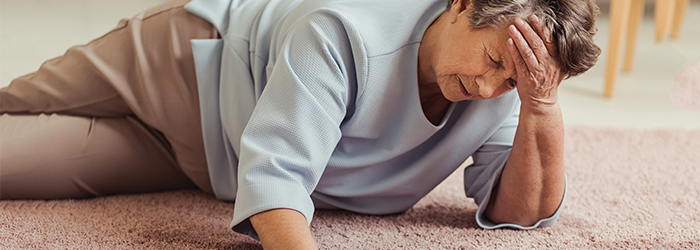Preventing Falls in Elderly Patients Can Avoid Injury and Save Lives

It happens quickly and without warning. One moment, your elderly patient is standing upright, leaning against a chair, sitting on the edge of a bed or walking slowly … and the next minute, the patient is on the ground.
On average, an older American falls every 17 seconds, making falls a leading cause of injury and the leading cause of injury-related death among people 65 and older, according to the US Centers for Disease Control.
People of all ages can lose their balance or trip for any number of reasons, but falls in the elderly are typically the result of three kinds of factors: environmental, personal and health/medications.
Identify Risk Factors, then Take Action
Here’s a look at what causes falls and how to reduce their incidence:
- Environmental Factors: Falls can often be linked to inadequate lighting, cluttered stairways, slick or irregular floors, uneven area rugs, improperly maintained wheelchairs, inadequate footwear or eyewear, furniture that is too high or too low, and lack of hand grips or supports in bathrooms and at the bedside.
- Personal Factors: Age, lack of physical fitness and poor dietary habits contribute to falls. Alcohol, smoking and lack of exercise can decrease bone strength and balance. Inadequate water/fluid intake can deplete strength and energy.
- Health Factors: Older people are prone to falls if they are weak, have a history of falls, use an assistive device (such as a cane or walker), have a cancer that affects the bones, are visually or hearing-impaired, are depressed, have dementia/Alzheimer’s disease, exhibit gait limitations, experience cardiac arrhythmias or experience fluctuating blood pressure.
- Medication Factors: Some medications are linked to a risk of falls, including sedatives, anti-anxiety drugs, antidepressants and anti-hypertensives. Anti-coagulants/blood thinners and aspirin can lead to excess bleeding or blood loss after a fall.
An Assessment and Fall-Prevention Action Plan
As a healthcare professionals, you and your colleagues should assess elderly patients for their risk of falling. High-risk individuals include those who have a history of falls or falling out of bed, are unable to walk/move safely, cannot transfer safely from a bed to a wheelchair, and are inconsistent about asking others for help.
If patients are at high risk for falls, an interdisciplinary safety care plan should:
- Educate the patient, family and caregiver about moving and transferring safely
- Assess medication use and consider discontinuing medications that are unnecessary, inappropriate or ineffective
- Support the use and installation of assistive devices and safety equipment, including canes, walkers, hand rails, bathtub grips, bed rails, hip protector garments/pads, bed rails, and a regular “look up/look down assessment” to make sure the person is wearing stable shoes and properly fitted eyewear. Portable commodes and urinals should be placed close to an elderly person’s bed.
- Encourage physical activity and exercise as tolerated by the patient to increase strength, balance and situational awareness
- Monitor patient activity via regular schedules, electronic or baby monitors, and avoidance of the “I’ll be right back syndrome” by caregivers
- Remove area rugs and loose/unsafe floor coverings that can cause tripping or interfere with walking/navigating
- Provide oxygen (when necessary) to prevent dizziness and confusion
- Encourage a healthy diet, including plenty of fluids, no smoking and limited alcohol intake
Falls can evolve very quickly into life-altering, life-limiting injuries. Preventing falls is a far healthier strategy, especially for older patients who are most at risk.

Check Hospice Guidelines
Get diagnosis-specific guidelines in our hospice eligibility reference guide.
Hospice Guidelines by Diagnosis Refer Your Patient